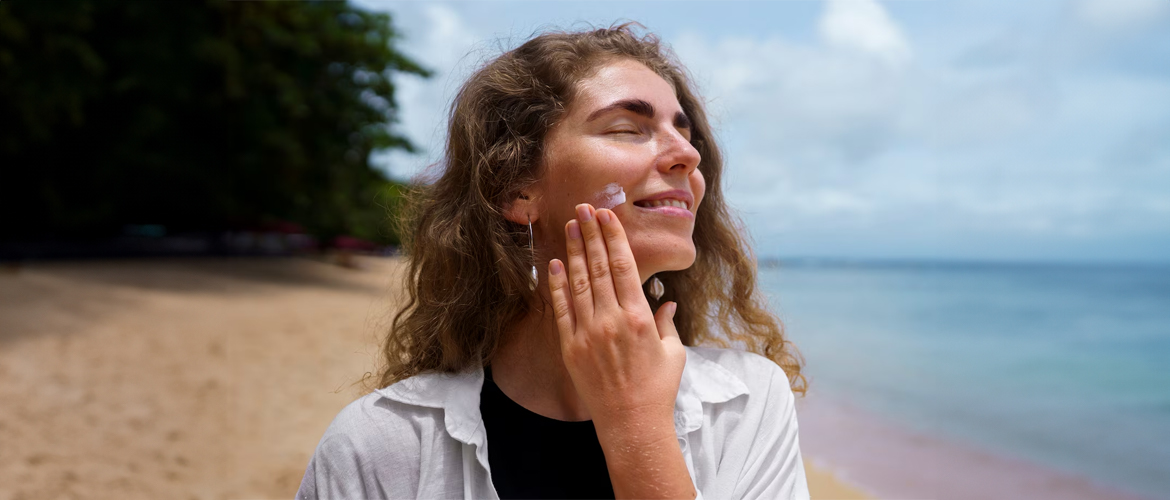What If Sunscreen Didn’t Exist? Let’s Just Say… Ouch!
Imagine a world without sunscreen. Every beach trip would end in a bright red sunburn, looking like a lobster instead of a tourist. Even quick trips outside could mean fried skin, wrinkles popping up early, and let’s not even talk about dark spots. Yikes!
Luckily, we don’t live in that world, it has our backs (and our faces, arms, and legs) every day. It’s like the invisible shield between us and the sun, silently fending off those UV rays that are just waiting to cause trouble.
So whether you’re soaking up rays at the beach, grabbing groceries, or just sitting by a window (yep, UV rays can sneak through!), sunscreen keeps your skin safe, fresh, and ready for the long haul. Think of it as a daily dose of protection you didn’t know you needed but now can’t live without.
Curious about how it all works, why it’s so important, and how to find the right one for you? Let’s dive into the sun-shielding magic of it, our skin’s trusty sidekick.
Things to Know Before Using Sunscreen
Knowing how to use it the right way can help protect your skin from harmful UV rays. Here are some simple tips to ensure you get the best protection from your sunscreen.
1. SPF Level
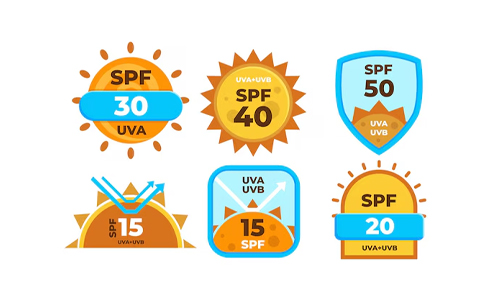
SPF stands for Sun Protection Factor. It shows how well it protects your skin from UVB rays, which cause sunburn. In the U.S., skin doctors recommend using it with at least SPF 30 every day. This type of sunscreen blocks about 97% of UVB rays. If you plan to be outside for a long time, choose a higher SPF for better protection.
2. Broad Spectrum
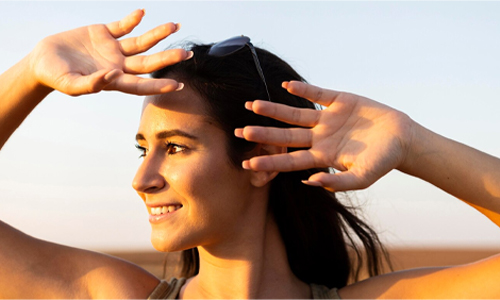
When it is labeled “broad spectrum,” it means it protects against both UVA and UVB rays. UVA rays can cause early skin aging and raise skin cancer risk, while UVB rays mainly cause sunburn. Broad-spectrum protects your skin well. Make sure to use it all day when you are in the sun.
3. Water Resistance
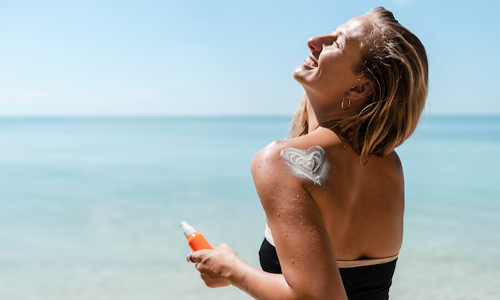
If it says it is water-resistant, it lasts for 40 or 80 minutes while you swim or sweat. This is important for beach trips, pool days, or intense workouts, as it helps keep your skin protected. Reapply it every two hours or after towel drying to stay protected.
When Should I Use It?
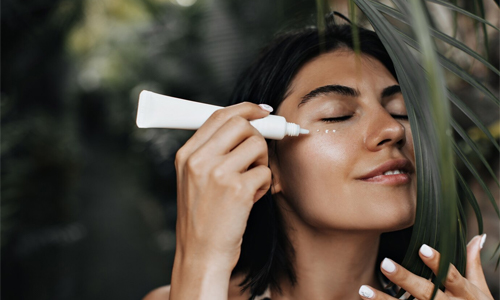
Wear it every single day! Yes, even on cloudy days, in the winter, or if you’re just heading out.
Many people think UV rays are only a problem on sunny days, but they can get through clouds and windows. This means your skin can be harmed all year.
Using it daily is just as important as brushing your teeth. Put it on as the last step in your morning routine. Remember to reapply it during the day, especially if you are outside for a long time. This helps prevent sunburn and lowers the risk of long-term skin damage and early aging.
Who Should Not Use It?
It is safe for almost everyone and is an essential part of skin protection. If you have allergies or sensitivities to avobenzone or oxybenzone, be cautious. It’s crucial to read the ingredients list carefully before purchasing any product.
If you have allergies or react to certain chemicals, talk to your dermatologist. They can suggest safer options, such as mineral sunscreens with zinc oxide or titanium dioxide, which are easier on sensitive skin. If you have rosacea or eczema, it’s best to get advice to find a product that won’t irritate your skin. Taking care of your skin and picking the right products is key for safe sun exposure.
Types of Sunscreens?
Gone are the days of thick, sticky creams that made your skin look pale and ghostly. Now, you can find it for different skin types, activities, and preferences.
Here’s a guide to help you select the best option for your needs.
1. Mineral
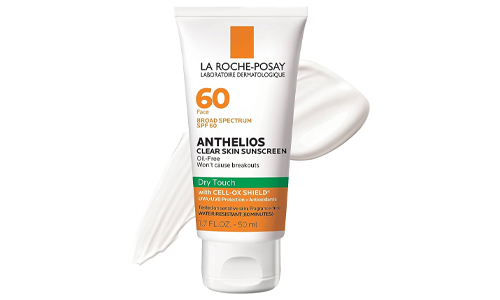
This can sit on your skin and reflect UV rays with zinc oxide and titanium dioxide. They are good for sensitive skin because they stay on the surface, which reduces irritation and breakouts.
| SPF Range | Top Picks | Perfect For | Where to Buy | Bonus Tip |
| SPF 30-50+ | La Roche-Posay Anthelios Mineral SPF 50 | Sensitive skin, acne-prone skin, or those with rosacea | Sephora, Ulta, Target, Amazon | These are often labeled as “reef-safe” and are great for swimmers or snorkelers, as they’re free from harmful chemicals. |
2. Chemical
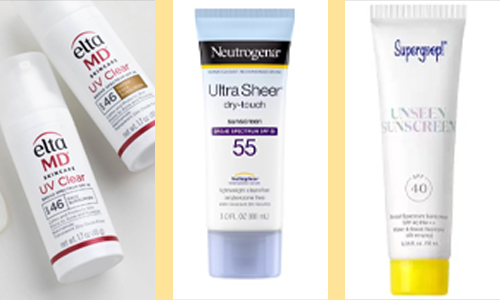
This will absorb UV rays, turn them into heat, and release them from the skin. They’re typically easier to rub in, making them a favorite for daily use under makeup or for a quick application.
| SPF Range | Top Picks | Perfect For | Where to Buy | Bonus Tip |
| SPF 30-60 | EltaMD UV Clear SPF 46, Neutrogena Ultra Sheer Dry-Touch SPF 55, Supergoop! Unseen SPF 40 | For those who want a lightweight feel without a white cast; great for darker skin tones | Amazon, Target, Ulta, Walmart | Good for outdoor activities, but not ideal for long water exposure since they wash off easily. Reapply often! |
3. Hybrid
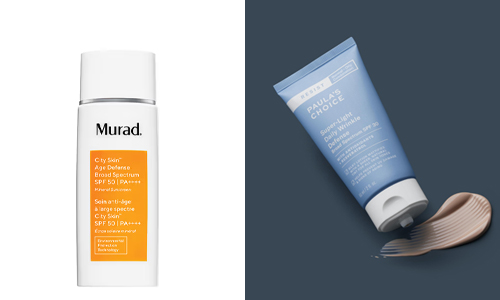
Hybrids work well under makeup and give a slightly matte finish. They are also great for oily skin types.
| SPF Range | Top Picks | Perfect For | Where to Buy | Bonus Tip |
| SPF 40-50 | Murad City Skin Age Defense Broad Spectrum SPF 50, Paula’s Choice Super-Light Daily Wrinkle Defense SPF 30 | Those who want a balance of lightweight texture and longer-lasting protection | Sephora, Dermstore, Amazon | Hybrids work well under makeup and provide a slightly matte finish, making them great for oily skin types as well. |
4. Tinted
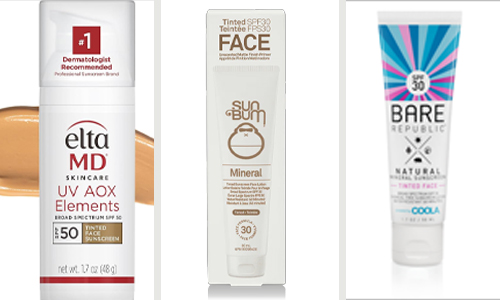
This offers sun protection with a touch of color. They’re perfect if you want light coverage and sun defense all in one step. Many also contain antioxidants to fight free radicals caused by the sun.
| SPF Range | Top Picks | Perfect For | Where to Buy | Bonus Tip |
| SPF 30-50+ | EltaMD UV Elements Tinted Broad-Spectrum SPF 44, Sun Bum Tinted Face Lotion SPF 30, Bare Republic Tinted Mineral Face SPF 30 | Everyday wear, especially if you want to skip foundation; is great for evening out skin tone | Amazon, Ulta, Target | These are a lifesaver for beach days or hiking when you want some coverage but don’t want to wear makeup. |
5. Mists & Sprays
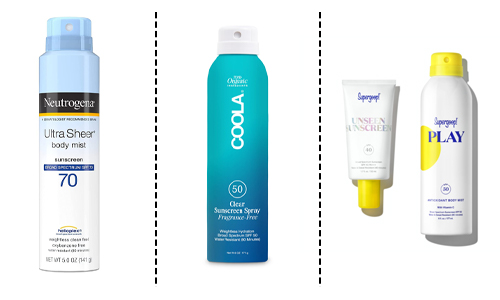
Sprays and mists are perfect for quick applications on the go. They are easy to apply and reapply throughout the day. These options are ideal for beach trips and outdoor activities. You can easily spray them over large areas for quick coverage.
| SPF Range | Top Picks | Perfect For | Where to Buy | Bonus Tip |
| SPF 30-70 | Neutrogena Ultra Sheer Body Mist SPF 70, Coola Organic Spray SPF 50, Supergoop! Play Antioxidant Body Mist SPF 50 | Outdoor sports, beach days, and anyone who dislikes the feel of lotion | Ulta, Amazon, Walmart | Use these to reapply over makeup (just close your eyes!). But be cautious—they’re easy to under-apply, so make sure you coat evenly. |
6. Water-Resistant and Sport
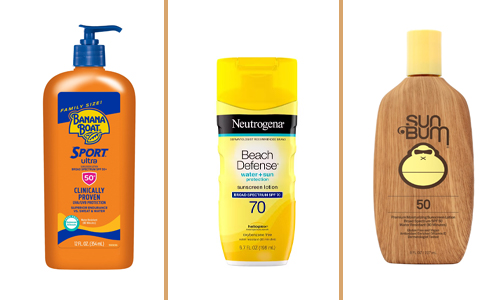
These products are made for swimmers, surfers, and outdoor lovers. They stay on through sweat and water. They offer longer-lasting protection, usually needing reapplication every 80 minutes during intense activity.
| SPF Range | Top Picks | Perfect For | Where to Buy | Bonus Tip |
| SPF 50+ | Banana Boat Ultra Sport SPF 50+, Neutrogena Beach Defense SPF 70, Sun Bum Original SPF 50 | High-intensity outdoor activities, swimming, and sports | Walmart, Amazon, Target, Walgreens | They’re thick, but that’s what makes them stay on. Just remember that “water-resistant” isn’t “waterproof,” so still reapply as needed. |
7. Sunscreen Sticks
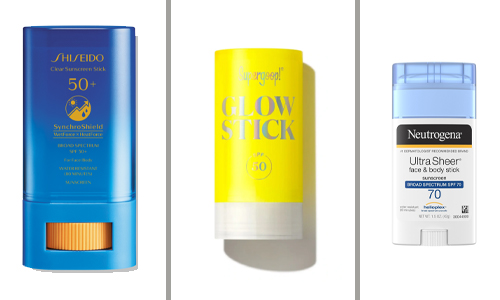
If you need a targeted application for areas like the face, ears, or neck, these sticks are your friend. They’re compact, easy to throw in a bag, and great for hard-to-reach places.
| SPF Range | Top Picks | Perfect For | Where to Buy | Bonus Tip |
| SPF 30-50 | Shiseido Clear Stick UV Protector SPF 50+, Supergoop! Glow Stick SPF 50, Neutrogena Ultra Sheer Stick SPF 70 | Quick touch-ups, sensitive areas, or specific coverage zones | Ulta, Amazon, Sephora | These are convenient for kids and can be a lifesaver for quick touch-ups on the go. |
8. Mineral Powder
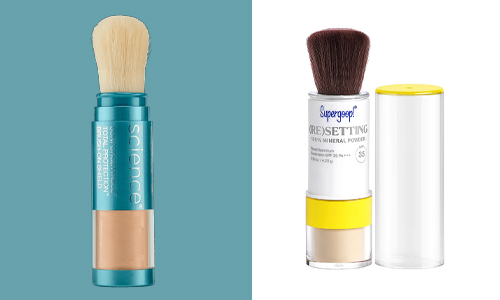
Mineral powder protects with a matte finish, making them perfect for oily or acne-prone skin. They’re ideal for reapplying throughout the day without disturbing your makeup.
| SPF Range | Top Picks | Perfect For | Where to Buy | Bonus Tip |
| SPF 30-50 | Colorescience Sunforgettable Brush-On Shield SPF 50, Supergoop! (Re)setting 100% Mineral Powder SPF 35 | Oily skin, touch-ups, and adding a layer of protection over makeup | Sephora, Amazon, Colorescience.com | Use powder sunscreen to soak up oil while protecting from UV rays. Great for those who avoid liquid sunscreen due to greasiness. |
9. Kid-friendly and Sensitive-Skin
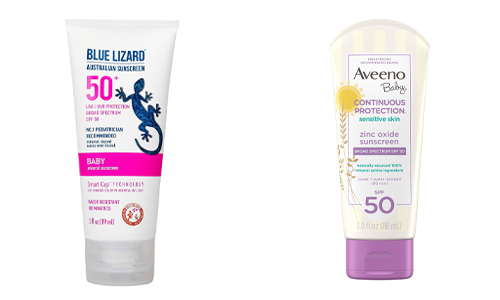
These are formulated with extra-gentle ingredients, free from potential irritants like fragrance and alcohol, making them safe for sensitive skin and children.
| SPF Range | Top Picks | Perfect For | Where to Buy | Bonus Tip |
| SPF 30-50+ | Blue Lizard Baby Mineral SPF 50+, Aveeno Baby Continuous Protection Sensitive Skin SPF 50 | Babies, young children, and sensitive skin types of all ages | Target, Walmart, Amazon | These are often labeled “fragrance-free” and “hypoallergenic.” Always patch-test on kids first, especially if they have allergies or skin conditions. |
10. Anti-Aging
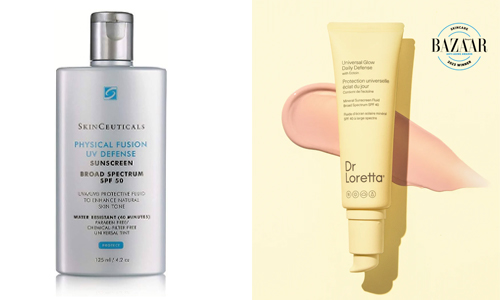
These are packed with anti-aging ingredients like antioxidants, peptides, and hyaluronic acid to fight free radicals and keep skin looking youthful while protecting it from the sun.
| SPF Range | Top Picks | Perfect For | Where to Buy | Bonus Tip |
| SPF 30-50 | SkinCeuticals Physical Fusion UV Defense SPF 50, Dr. Loretta Universal Glow SPF 40 | Mature skin or anyone concerned about premature aging | Dermstore, SkinCeuticals, Sephora | Look for it with “broad-spectrum” coverage to protect against UVA (aging) rays and UVB (burning) rays. |
Which of them Suits My Skin?
Finding the right brand of it isn’t a one-size-fits-all approach. Each skin type has different needs, so pick one that meets your specific concerns.
Here’s a guide to help you select the best option based on your skin type,
1. For Dry Skin
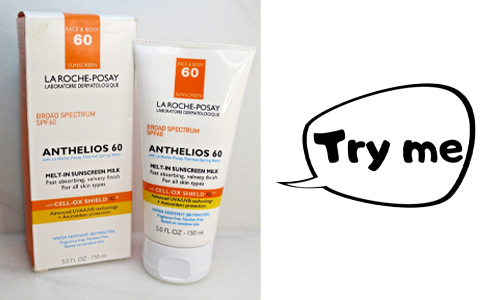
Choose a hydrating sunscreen with ingredients like hyaluronic acid, glycerin, or aloe vera. Chemical sunscreens are usually better for dry skin since they’re more moisturizing.
2. For Oily or Acne-Prone Skin
Non-comedogenic (won’t clog pores) and mattifying formulas work best. Mineral-based options can also help reduce excess oil.
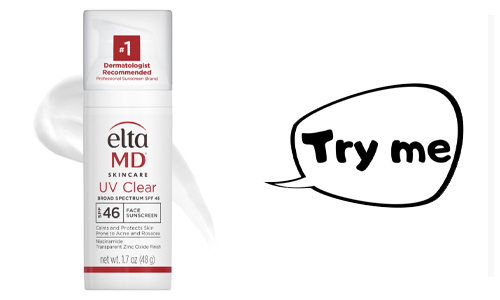
3. For Sensitive Skin
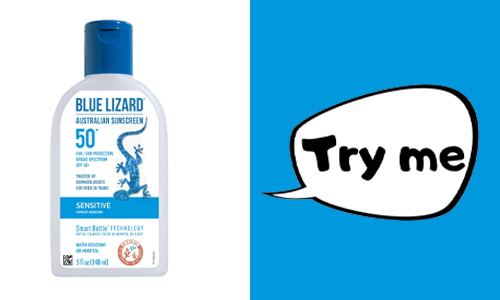
Choose fragrance-free, mineral sunscreens to avoid irritation.
4. For Combination Skin
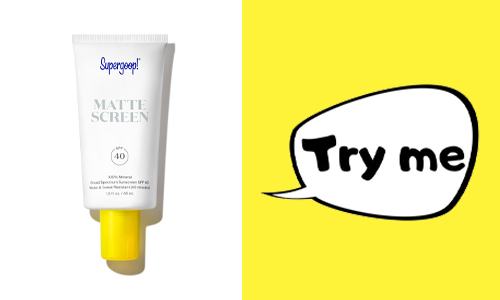
Go for lightweight, versatile formulas that hydrate without making the skin oily.
How Should I Test It?
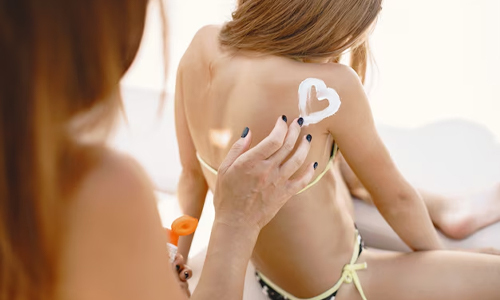
A patch test is your best friend when trying out a new product. To perform this test, apply a small amount of the product on the inside of your wrist or behind your ear. Then, wait 24 hours to see how your skin reacts. If you notice itching, redness, or irritation, it’s a sign to try a different formula.
This test is key for sensitive or acne-prone skin, as these types can react to certain ingredients. A quick test helps you see if the product works for your skin, lowering the chance of irritation and giving you confidence in using sun protection.
How to Apply It?
Applying it in the right way ensures you get full protection against the sun’s harmful rays. Here’s a step-by-step guide to help you get the most out of your SPF,
1. Choose the Right Amount
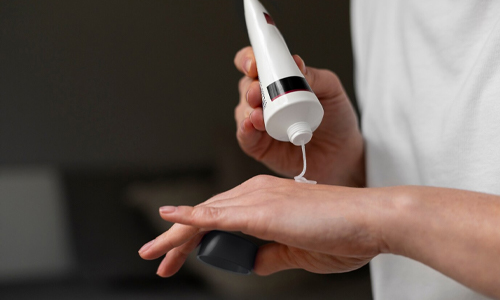
- For the face and neck, use about a nickel-sized amount (roughly two finger-lengths of the cream when squeezed onto your index and middle fingers).
- For your body, aim for a shot glass’s worth (around one ounce or 30 mL). Don’t skimp, as this amount is essential to achieve the SPF labeled on your product.
2. Apply to Clean, Dry Skin
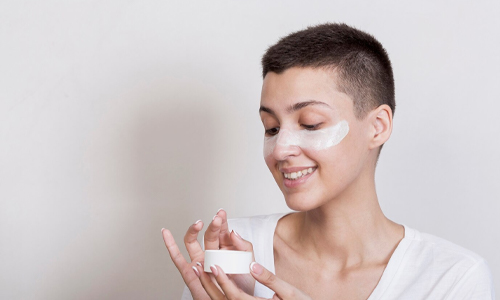
- Always start with clean, dry skin. Apply it as the last step in your morning skincare routine—after serums and moisturizers, but before makeup.
- Allow it to absorb for a few minutes before applying makeup to avoid pilling and ensure a smoother application.
3. Apply Evenly and Generously
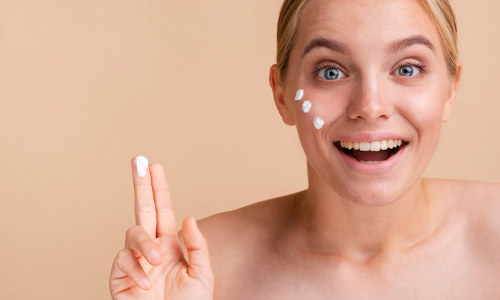
- Don’t rush! Spread it evenly over your face, neck, and any exposed skin. For sensitive areas (like around your eyes), dab gently, and consider using a product that is specifically formulated for the face.
- Don’t forget easy-to-miss spots like the tops of your ears, the back of your neck, the tops of your feet, and along your hairline.
4. Reapply Every Two Hours
- It isn’t a one-and-done product. To stay protected, reapply at least every two hours, especially after swimming, sweating, or towel drying.
- For quick reapplication on the go, try a spray or powder to layer over makeup.
5. Apply Indoors, Too
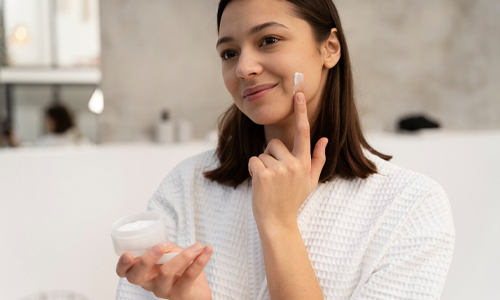
- UV rays penetrate windows, so even if you’re working indoors, a layer of it is still beneficial. Apply it year-round—even on cloudy days—since UV rays can still harm skin in indirect sunlight.
6. Use Different Types for Different Areas
If you find some formulas thick for your face, try using a lighter, non-comedogenic face cream and save the thicker body lotion for the limbs and torso. Try it as a spray for easy application for hard-to-reach areas like the back.
7. Don’t Forget Your Lips
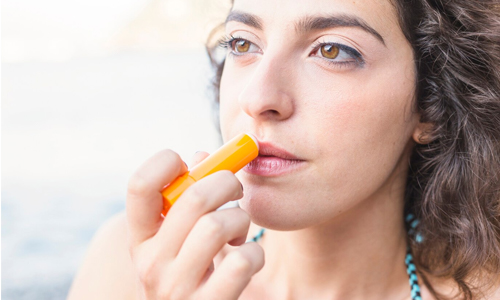
Use a lip balm with SPF to protect your lips from sun damage. Sun exposure can lead to chapping and increase the risk of skin cancers on the lips.
Can We Apply It On Babies?
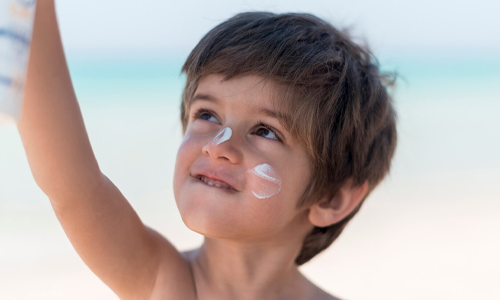
For babies under six months, avoid sunscreen as their skin is very sensitive. Instead, keep them out of direct sunlight as much as possible. Dress them in light, long-sleeved clothing and a wide-brimmed hat to shield their face and neck.
For babies over six months, you can introduce a gentle, mineral-based with an SPF of 30 or higher. Mineral sunscreens, which contain ingredients like zinc oxide or titanium dioxide, are often less irritating and provide effective protection by sitting on the skin’s surface and reflecting UV rays. A popular choice among parents is Blue Lizard Baby Mineral SPF 50+, known for its safety and effectiveness. Always consult your pediatrician for personalized advice, and remember to reapply it regularly, especially after swimming or sweating.
FAQ
1. How long does a bottle of it last?
Generally, it’s best to use it within a year of opening it. Expired it can lose its effectiveness.
2. Does the product expire?
Yes! Always check for the expiration date. An expired product may look and feel fine, but it won’t offer the full protection it should.
3. Can I apply it over makeup?
Absolutely! You can use a powder form of it like Colorescience Sunforgettable Total Protection Brush-On Shield SPF 50 or a spray for quick touch-ups.
4. How do I keep my eyes from stinging?
Mineral sunscreens are often less irritating, and using a water-resistant product around your eyes can also help.
5. Is there a difference between “reef-safe” and regular sunscreen?
Yes. Reef-safe doesn’t contain harmful chemicals that can damage coral reefs, making them eco-friendly choices. It’s not just about preventing sunburns, it’s also about maintaining your skin’s health. Now you know about the best of it for 2025, you’re ready to enjoy the sun with confidence. Apply your sunscreen, reapply often, and enjoy the sun knowing your skin is safe. Here’s to sun-kissed, healthy skin!
Stephenie
Related posts
Women Tips
Privacy Overview
| Cookie | Duration | Description |
|---|---|---|
| cookielawinfo-checkbox-analytics | 11 months | This cookie is set by GDPR Cookie Consent plugin. The cookie is used to store the user consent for the cookies in the category "Analytics". |
| cookielawinfo-checkbox-functional | 11 months | The cookie is set by GDPR cookie consent to record the user consent for the cookies in the category "Functional". |
| cookielawinfo-checkbox-necessary | 11 months | This cookie is set by GDPR Cookie Consent plugin. The cookies is used to store the user consent for the cookies in the category "Necessary". |
| cookielawinfo-checkbox-others | 11 months | This cookie is set by GDPR Cookie Consent plugin. The cookie is used to store the user consent for the cookies in the category "Other. |
| cookielawinfo-checkbox-performance | 11 months | This cookie is set by GDPR Cookie Consent plugin. The cookie is used to store the user consent for the cookies in the category "Performance". |
| viewed_cookie_policy | 11 months | The cookie is set by the GDPR Cookie Consent plugin and is used to store whether or not user has consented to the use of cookies. It does not store any personal data. |

